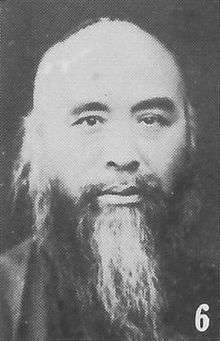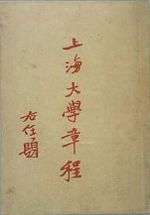Yu Youren
| Yu Yu-jen | |
|---|---|
 于右任 | |
| Born |
April 11, 1879 Hedaogang, Sanyuan County, Shaanxi Province, China |
| Died |
November 10, 1964 Taipei |
| Occupation | Educator, Calligrapher, Politician |
| Nationality |
|
| Period | Republican China |
Yu Yu-jen (Chinese: 于右任; pinyin: Yú Yòurèn); (April 11, 1879 – November 10, 1964) was an educator, scholar, calligrapher, and politician in the Republic of China.
Early life
He was born on April 11, 1879 in the town of Hedaogang in Sanyuan County, Shaanxi Province north of Xi'an, China. His father was Xin Sangong and his mother surnamed Zhao. In 1880, while his father was on business in Sichuan, his mother died and so his aunt brought him to live with her in the village of Yangfu where they lived together for 9 years. After a short stint as a goat herder, he went to a private school at the Mawang Temple in Yangfu and studied under Mr. Diwu. In 1889, he returned with his aunt to Sanyuan and entered the school of Mao Banxiang, under whom he began to study archaic and modern forms of poetry. On occasion, he also had the chance to read a few poems by such Southern Song patriots as Wen Tianxing and Xie Fangde. At the age of 17, he came in first place on entrance examinations and went on to study at the schools like the Dao Academy in Sanyuan, Weijing Academy in Jingyang, and Guanzhong Academy. In 1898, he married Miss Gao Zhonglin.[1]
Revolutionary beginnings
In 1900, at the age of 22, Yu Yu-jen wrote a letter for the Pacification Commissioner of Shaanxi, Cen Chunxuan, imploring him to take the opportunity of assassinating the Empress Dowager Cixi who was fleeing to Xi'an during the Boxer Rebellion, which would provide the impetus for true reform of the government, but Yu was stopped from sending it by his classmate Wang Linsheng. Yu wrote many poems venting anger and frustration with the government. These were collected into a book entitled Poetry Drafts from the Hall of Tears and Mockery. His friend Meng Yimin helped Yu to have it published.
In 1903, he passed the civil service examinations to become a Provincial Graduate (juren), but due to the satiric contents of Poetry Drafts from the Hall of Tears and Mockery, the government branded him a revolutionary. Wanted by the Qing government, Yu fled and sought refuge in Shanghai. With help from Ma Xiangbo, he was able to enter the Aurora Academy (later Aurora University (Shanghai)) under the assumed named of Liu Xueyu. Along with Ye Zhongyu and others, Yu established the Fudan College (later Fudan University) in memory of his days at Aurora (using the same character dan in Zhendan, the Chinese name of Aurora, and adding the character fu, for "reviving" China). Ma Xiangbo was elected as school president.
In 1906, Yu fled to Japan and while there was able to meet Dr. Sun Yat-sen and the Tongmenghui through the introduction of Kang Xinfu and he thereafter officially joined the Tongmenghui. After returning to China in 1907, Yu started a newspaper called The National Herald (also known as the Shenzhou Daily), but its facilities were destroyed in a fire less than a year later. In the following year, Yu's father died. In March 1909, Yu established another newspaper called The People's Voice (Minzhu Bao) in Shanghai, strongly condemning the culture of corruption in government. Attracting the attention of officials, he was arrested and sent to jail, and the newspaper was closed in June 1909. Released from jail and still undaunted, he established another newspaper called The People's Sigh (Minxu Bao) but less than two months later it was shut down and he was thrown in jail again. In 1910, he established yet another newspaper called the Min Li Pai, the offices of which virtually served as the contact headquarters for the Chinese Revolutionary Alliance.[2]
Post Xinhai Revolution

In 1912, Yu Yu-jen is nominated to and accepts the post of Deputy Minister of Transportation and Communication, but less than three months later is forced to resign along with Dr. Sun Yatsen's government. After Yuan Shikai took control of the government and the Min Li Bao is shut down, Yu was placed on the wanted list by Yuan Shikai's government. In 1918, Yu returns to his native Shaanxi Province, where he becomes commander of forces responsible for revolutionary activities in the northwest. In 1922, his post as commander is disbanded and he returns to Shanhai where he established Shanghai University along with Ye Chucang and assumes the post as president of the school. In 1925, he is ordered to organize along with Wu Zhihui, Wang Jingwei, and others the political affairs committee to handle party affairs. In 1927, Yu becomes a standing member of the Nationalist government committee. In the following year, he is also appointed as the Director of Audit. In 1932, Yu assumed the post of Director of the Control Yuan.[3]
In 1936, Yu collects examples of Chinese characters and compiles them into the "Thousand character essay in Standard Cursive Script" as the book Standard Cursive Script, the first edition of which is published. Yu also donated his entire collection of more than three hundred rubbings from Stele to the Xi'an Forest of Stele Museum.
In 1941, along with other members of the art and cultural world, Yu takes the initiative to name the fifth day of the fifth lunar month every year as Poets' Day. Yu also meets the modern painting master Zhang Daqian at Dunhuang in Northwest China and comes to realize the amount of destruction that has occurred to the art and cultural heritage at Dunhuang. After returning to the government headquarters in Chongqing, he immediately proposes that a Dunhuang Art Academy be established.
Following the loss of Mainland China to Communist forces, Yu follows the Chinese Nationalist government to Taiwan in 1949 at the age of 71.[4]
In Taiwan
In 1950, after the establishment of the Kuomintang (Chinese Nationalist Party) committee, Yu became a member of its review committee. In 1956, Yu received the first National Literary Award presented by the Ministry of Education. In arranging his diaries in 1962, Yu wrote poetry revealing pain at not being able to return to his hometown in China. Yu died from pneumonia in 1964 at Taipei Veteran's Hospital and in 1967 his remains were interred at Datun Mountain in Taipei's Yangmingshan National Park. In 1966 a large bronze statue of Yu Yu-jen was placed at the summit of Yushan. The statue remained there until 1996 when it was cut down and thrown into a ravine by Taiwan independence activists.[5][6]
Calligraphy
Yu was a scholar of calligraphy and is regarded as one China's modern masters. His works in cursive and semi-cursive manner are intensely animated. He is perhaps best known for his calligraphy and published related works on the topic. Because his later years were spent in Taiwan, his writing style is very popular and his works are considered very desirable by collectors. Yu completed numerous inkworks, stone carvings, and title plaques while living in Taipei including works for the National Museum of History, Din Tai Fung, Xingtiang Temple, and the Shilin Official Residence.[7]
The Pamir Snow Gnawing Association (帕米爾齧雪同志會) established a cultural park known as the Pamir Cultural Park in a quiet and secluded mountainous area of Taipei City called Wuzhishan. The park commemorates about 300 KMT soldiers who hid out in the Pamir Mountains after the Chinese Civil War and were able to eventually escape to Taiwan.[8] It had engraved at the site examples of the titles and poetry of Yu Yu-jen into stones and rocky outcroppings, forming a beautiful outdoor garden of his calligraphy. Among the hills of the area is an open space where the association erected a monument. Each of the characters for the title calligraphed by Yu Yu-jen was engraved into individual slabs of marble and then inlaid into a concrete pillar.
Gallery
 Title Plaque by Yu Yu-jen at Xingtian Temple in Taipei
Title Plaque by Yu Yu-jen at Xingtian Temple in Taipei Chinese guardian lions at the entrance to the Tomb of Yu Yu-jen in Yangmingshan National Park, Taipei
Chinese guardian lions at the entrance to the Tomb of Yu Yu-jen in Yangmingshan National Park, Taipei
 Statue of Yu Yu-jen at the Sun Yat-sen Memorial Hall in Taipei
Statue of Yu Yu-jen at the Sun Yat-sen Memorial Hall in Taipei
See also
- Lawrence Lau - Yu Yu-jen's Grandson.
- Puru (artist)
- Chang Dai-chien
- Chatham Square, Manhattan
References
| Wikimedia Commons has media related to Yu Youren. |
- ↑ http://webtitle.nmh.gov.tw/yuyouren/41_cn.html
- ↑ http://webtitle.nmh.gov.tw/yuyouren/41_cn.html
- ↑ http://www.yuyouren.com/InfoShow.asp?ArticleID=449
- ↑ http://webtitle.nmh.gov.tw/yuyouren/41_cn.html
- ↑ 玉山-{于}-右任像斷頭 元凶說始末, Liberty Times, February 13, 2007
- ↑ http://www.yaojuichung.com/pdf/en/recovering_the_mainland_and_liberating_taiwan.pdf
- ↑ http://webtitle.nmh.gov.tw/yuyouren/43_en.asp
- ↑ Poetry Exhorting the Pamir Comrades
- Yu Lian-hwa, An Encyclopedia of Chinese Artists, Shanghai, 1980, page 13.
External links
- Straddling East and West: Lin Yutang, a modern literatus: the Lin Yutang family collection of Chinese painting and calligraphy, an exhibition catalog from The Metropolitan Museum of Art Libraries (fully available online as PDF), which contains material on Yu Youren (see table of contents)
- Yu Youren's Tomb